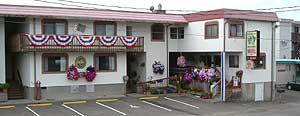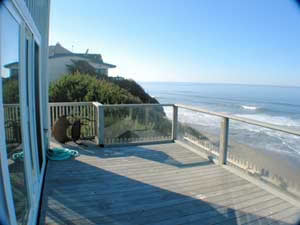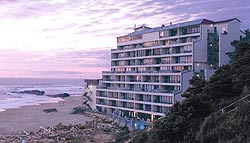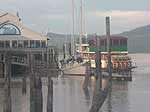 |
Freaky Oregon Coast Facts #6: Scary Lava Flows, Famous Helicopters, and Movies on the Oregon Coast - Each week in Dec and Jan BeachConnection.net releases a new set of weird, wild and freaky facts |
|---|
Covering 180 miles of Oregon coast travel: Astoria, Seaside, Cannon Beach, Manzanita, Nehalem, Wheeler, Rockaway, Garibaldi, Tillamook, Oceanside, Pacific City, Lincoln City, Depoe Bay, Newport, Wadport, Yachats & Florence.
1/19/07
Secrets of the Season |
Scary Lava Flows, Famous Helicopters, and Movies on the Oregon Coast
 |
| Cannon Beach's Haystack Rock: you won't believe what's behind this landmark |
(Oregon Coast) – It’s again proof that more lurks on the Oregon coast than meets the eye. In fact, sometimes you have to either go back millions of years in time or way beneath the Earth’s crust to really understand it. Other times, you’ve got to look up, or be part of the in-crowd and get invited to the celebrity parties.
What was the unfathomably enormous series of catastrophes that created all the beauty of the Oregon coast? What famous names are associated with one attraction in Seaside? And what movies were filmed on Oregon’s coast, and what are the interesting secrets they hold to the area?
You won’t believe what you’ll read next.
Scary Rivers of Lava on the Coast
Picture this: a massive river of lava erupts in Idaho, so big it covers miles at a time as it marches along around 4 mph. It sears entire forests into ashes and fumes. It builds gigantic damns of molten rock that are perhaps miles long, sometime bulging up to 20 feet high. It marches its way through riverbeds and canyons, snaking its way around mountains, until it slithers its sinister, scorching heat into the ocean – some 300 miles - about seven days later. It’s hundreds of miles long, spewing out continuously and fiercely so that when it reaches the ocean it fills crevices and muddy areas thousands of feet deep.
 |
| Cape Foulweather, the product of lava flows hundreds of miles long |
This was the scene in Oregon some 15 million years ago, and it was the beginning of the birth of many of the incredible structures and tourist attractions you now see on the scenic Oregon coast. A colossal fissure in the Earth around Lewiston, Idaho, poured these horrendous flows into this area (it’s the same hot spot that now powers Yellowstone National Park, and has before created the mega-disastrous super volcanoes that have erupted a few times over the millennia). The coast at that time was about 15 miles farther inland than it is now. Sometimes these lava flows poured into the ocean, spread out through the soft marine sediments for dozens of miles, and then managed to re-erupt through thousands of feet of muck, onto the sea floor, essentially making their own eruptions for a brief time (geologically speaking).
|
Tradewinds Motel, Rockaway Beach. All rooms at the Tradewinds Motel are immaculate and have TV’s, VCR’s and in-room phones with data ports. The oceanfronts all have a queen bed, a double hide-a-bed, kitchen, cozy firelog fireplace and a private deck. Some oceanfront units come with all those amenities but the kitchens. Both types sleep up to four people. Others are appointed with a queen bed, small fridge, and coffee maker – sizable for a two-person romantic getaway, yet still perfect for those on a budget. There is an elaborate oceanfront Jacuzzi suite that has two bedrooms, coming with a kitchen, double hide-a-bed, fireplace and private deck, sleeping as many as six. For those wanting bigger accommodations for family reunions or large gatherings such as weddings, some rooms can connect to create two-room and three-room suites. Some rooms are pet friendly.523 N. Pacific St., Rockaway Beach. (503) 355-2112 - 1-800-824-0938. www.tradewinds-motel.com |
Over millions of years, some of these massive invasions of lava (solid basalt) were lifted with the sediments above sea level with the rising of the coast range. They in turn were eroded away, until they formed headlands and features we now know as Neahkahnie Mountain near Manzanita or Tillamook Head between Seaside and Cannon Beach.
Another kind of lava flow that formed the headlands we know and love is called intra-canyon flows. These snaked their way to the coast through riverbeds and around other features, arriving at the coast to build up and up out of deltas of rubbly submarine pillow basalt, which were capped by sheets of dry-land lava flows.
 |
| Tillamook Head, Seaside |
They too were eroded by time and water into shapes we now know as Cape Foulweather, Cape Lookout, Yaquina Head and Cape Meares.
Numerous such lava flows (perhaps around 300) erupted from about 12 million years ago to 17 million years ago, according to Seaside resident and geologist Tom Horning. They happened approximately every 100,000 to 200,000 years, creating their own kind of havoc, but in turn laying the groundwork (pun intended) for the beauty we now see.
Meanwhile, millions of years earlier, Cascade Head was its own volcano, said Horning of large, looming headland just north of Lincoln City. And what about those mini-eruptions that happened just offshore? Horning said they’re often responsible for many of the coast’s most famous landmarks.
 |
| Cape Meares, near Tillamook |
“Haystack Rock in Cannon Beach was one of those,” Horning said. “Sea stacks are often from submarine feeders for the re-erupting lavas. They’re all part of plumbing systems.”
Weiss' Paradise Suites & Vacation Rentals - Seaside Unique Luxury Accommodations in Seaside. 1BR Suites,
1BR & 2BR Duplex Units and 3BR Houses, units for 2-8 people.
Rent our entire property for 20-26. All units close to beach, river
and Broadway St. |
Erosion also plays a major part in what you see with the famous structure (which is currently the third highest sea stack in the world), along with the oceans rising, falling and the land doing the same.
“The basalt that Haystack Rock is made of is about 15 million years old,” Horning said. “It was an enormous hill of rock until about 3000 years ago, when rising sea levels allowed the surf to wash away all but the strongest lava/basalt. Some 4000 to 5000 feet of the original submarine volcano is missing from it now, having been eroded for more than 12 millions years.”
 |
| Seaside Helicopters |
Seaside Helicopter Celebrities
If those faces on the pilots of the famous helicopter ride look a bit familiar, well, you’ll be correct with one, anyway. The other one has a name you’ll recognize, but it’s just an interesting coincidence.
Gary Turel is the main man behind Seaside Helicopters – an aviation aficionado who is living his dream as a pilot since retiring from the glitz and glam of the tax accounting world. Turel owned a tax firm known as Columbia Turel with his brother since the 70’s. In the 90’s, they were a fixture on Oregon TV with a regular dose of commercials that sort of made them celebrities. They also had a regular tax advice radio show for a while in the Portland area.
A few years ago, Turel bought the Seaside Helicopters business after selling the tax biz to a larger company.
Around 2005, he hired John Glen as a second pilot. Not the astronaut John Glenn – but a local man with the same name but different spelling. Glen told BeachConnection.net last year he’s been a real trouper about the similarity and has let his bosses get lots of mileage out of his name. This started back in the 60's, during his high school days, as the famous John Glenn was making orbits. The more earthly then-teenaged Glen was a delivery driver for a store, and his boss used Glen's name to jokingly tout his business. The delivery vehicles were even named "capsule 1" and "capsule 2."
Lincoln City Vacation Homes There’s something for everyone among this selection of wondrous homes: smaller homes with a view to a large house that sleeps 15. All the homes are either oceanfront or just a few steps away from the sand – all with a low bank access and fantastic views. Most are in the Nelscott area; one is close to the casino. You’ll find a variety of goodies, depending on the home: fireplaces, multiple bedrooms, dishwashers, Jacuzzis, washer/dryers, hot tubs, cable TV, VCR, barbecues; there’s a loft in one, and another sprawling home has two apartments. Pets are allowed in some homes – ask ahead. Each comes with complete kitchens so you’ll have a home away from home. Most have the seventh night free. Prices range from winter $85 to summer $230 per night. www.getaway2thecoast.com. 541-994-8778. |
Hollywood and the Oregon Coast
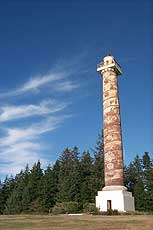 |
| Astoria |
It’s a longtime love affair that Hollywood has had with the Oregon coast, going all the way back to 1908 and the first film made in Oregon. That was, according to the Oregon Film & Video Office, “The Fisherman's Bride,” which was made in Astoria.
Seaside saw the first real wave of filming on the coast since that initial flick. It took another 50 years, but parts of “The Great Race” were filmed just north of Seaside in 1965.
In Lincoln City, the third movie filmed in the state was Ken Kesey's “Sometimes A Great Notion” in 1970. One famous spot from the movie is a building along the river - where the Kernville Steak and Seafood House now sits. In 1975, the Central Coast also hosted part of Kesey's “One Flew Over the Cuckoo's Nest,” (though the lion’s share was filmed at the state mental facility in Salem).
In Newport: “Hysterical” was filmed here in 1981, as well as in Depoe Bay and Cannon Beach. “The Hardy Boys” filmed a Halloween episode inside the Yaquina Head Lighthouse. The production crew was later sued by state authorities because they trashed it. You'll also find 1991's "Frameup" and the first "The Ring" with tidbits of this area. “Fahrenheit 9-11” had a bit filmed in Florence.
The erotic “Claire of the Moon” has chunks of the northern coastline in it. Parts of “Point Break,” starring Keanu Reeves, were made in Cannon Beach and Wheeler (until a few years ago, there was an antique shop in Wheeler that had an autographed photo of Reeves on the wall, signed to the owner, calling her "Mom"). “The Temp” came out of this area in the early 90's as well.
 |
| "Goonies" Rock in the distance - a Cannon Beach landmark that is a point of pilgramage for the cult-like following of the film who actually show up in considerable numbers each year to see movie sites |
Astoria didn't show up again in the annals of film history until 1981, with “California Mix.” Shortly after, it grabbed the lion's share of films produced on the coast. "Short Circuit," both installments of “Free Willy,” “Kndergarten Cop,” “Teenage Mutant Ninja Turtles III” and of course, “Goonies” are part of this town's history now. Parts of “Goonies” were made in Cannon Beach as well. Most recently, “The Ring II” was one of the last times Hollywood touched down here. A Sean Penn film (as yet unfinished) spent considerable time filming in Astoria, southern Washington and in parts of Beaverton in 2006.
DIVE
INTO LUXURY, HISTORY AT THE TIDES THE
TIDES BY THE SEA, Seaside. For over 80 years, The Tides has
been a favorite of Seaside visitors. History meets modern luxury
here. 51 oceanfront condos, individually owned and decorated. Find
suites for couples, small apartments with fireplaces and kitchenettes,
one or two bedroom family units with fireplaces, kitchens and dining
rooms. There are wonderful oceanview cottages that sleep anywhere
from two to eight people, with two bedrooms, some with lofts, fireplaces
and kitchens. |
“Cthulhu” is the name of another bit of celluloid to cash in on the atmosphere of Astoria and the north Oregon coast. The indie film is based on the spooky story “The Shadow Over Innsmouth” by horror vanguard H. P. Lovecraft.
The movie stars Jason Cottle, Tori Spelling, Cara Buono and Brian Padilla, and no firm release date has been set.
 |
| Del Rey Beach |
In an interview with Fangoria Magazine published online, one of the movie makers revealed that a former Astoria resident told him he believed Astoria was the real Innsmouth, pointing to some 40 aspects of this area of Northwest Oregon and Innsmouth that were very similar. One example was that in Lovecraft’s story, a ship called the “Alert” played a role in the plot. While filming, the crew was alerted that there was actually a U.S. Coast Guard cutter by the same name docked in Astoria.
Some parts of the movie were filmed on Del Rey Beach, where some 200 extras dressed as monsters were captured coming out of the water.
In other fun Hollywood coincidences, an episode of the now-defunct NBC series “Surface” featured the Oregon coast as a setting for one part: type ran at the bottom of the screen proclaiming the location of that scene to be Seaside, Oregon. Interestingly enough, one scene that featured two characters calling from a phone booth outside a gas station store looked a bit like the triangle-like area where Holladay meets Highway 101.
 |
| Mysterious Manzanita |
Manzanita indirectly got an interesting bit of the Hollywood treatment two years ago with the 2005 remake of the John Carpenter classic horror film “The Fog.” It was set in a fictional island off the north Oregon coast with some eerie similarities. No shots of Neahkahnie Mountain or Manzanita were in the movie, but the town, like the one in the film, has rumors of buried treasure and legendary shipwrecks.
A movie also filmed in 2005 in Tillamook County does focus on Manzanita and its legends, however. Bright Light Studios of Santa Monica, California, filmed “Tillamook Treasure” in Tillamook and Manzanita, including footage at a Fourth of July parade in Manzanita.
The movie is described by co-producer Richard Doyon as a family flick about a family that moves to the area, and the daughter goes treasure hunting on Neahkahnie Mountain.
Doyon co-wrote the
script with his wife, Portland native Jane Hall, who spent much time in
Manzanita while growing up. No word yet on when it will be released.
|
D Sands Condominium Motel, Lincoln City. Getting a free, fresh baked cookie upon check-in is just the beginning. Every room is beachfront, and it's all right up against Lincoln City's most famous stretch of beach, next to the D River. Each room, comes as a suite or mini-suite, and has a kitchen and balcony or patio. Some have gas fireplaces, while all have a DVD Players with movies available for renting (and movie rentals come with free popcorn). There's a heated indoor pool, a spa, and this fabulous beach is lit at night. Rooms sleep anywhere from two, four to six - including a deluxe fireplace suite. Gift certificates are available, and they offer special occasion packages as well. To make a reservation and see a virtual tour of the rooms, visit our website at www.dsandsmotel.com. 171 S.W. Highway 101. 800-527-3925. |
|
Inn At Spanish Head, Lincoln City. It's Lincoln City’s only resort hotel built right on the beach with all oceanfront rooms - nestled against a rugged cliffside overlooking a soft, sandy beach. Enjoy dining in the penthouse restaurant and bar - whether you’re in the mood for a casual meal or a candlelight dinner. They offer an array of seafood specialties, juicy steaks and other Northwest favorites, including a decadent Sunday buffet. Rooms range from bedrooms to studios to one-bedroom suites with microwaves and refrigerators to full kitchens. Hotel amenities include wi-fi, spa, saunas, exercise room and a year-round heated swimming pool. Kids will love the game room and easy beach access. Full-service conference and meeting rooms for that inspirational retreat; extensive, gorgeous wedding possibilities. Near the south end of Lincoln City at 4009 SW Highway 101. 1-800-452-8127 or 541-996-2161. www.spanishhead.com |
RELATED STORIES
Top Oregon Coast Tourism Stories of 2006 Strange fish, big storms, paranormal articles and plenty of natural fun topped the list
Stunning Storm Watch Spots on Oregon's Coast Tips for some stunning viewing of the wild waves of the season
Odd Oregon Coast: Castles, Carnivore Plants, Edible Beach Goo Things can make you mmm on the beach, freaky landmarks, eco-friendly surprises and creepy plants
Day or Night Mysteries and Merriment on Oregon Coast It's more than just nightlife that comes to life, but the beaches offer major opportunities
Sampling Wines and Wine Bars on the Oregon Coast Wine shops and wine bars are a growing part of coastal tourism
SPECIAL
SECTIONS |
|||||||||||||
| oregon coast weather | |||||||||||||
| oregon coast mileage chart & map | |||||||||||||
| day trips, suggested itineraries | |||||||||||||
| Search BeachConection.net's 800 pages | |||||||||||||
| Oregon Coast Real Estate | |||||||||||||
OR
TAKE THE VIRTUAL TOUR |
|||||||||||||
|
A1 Beach Rentals, Lincoln City. Perfect for large family vacations all the way down to a getaway lodging for two - with over 25 vacation rental homes to choose from. A breathtaking collection of craftsman or traditional beachfront homes, or oceanview houses – from one to seven bedrooms. In various areas of Lincoln City and overlooking the beach, with some in Depoe Bay. All kinds of amenities are available, like hot tubs, decks, BBQ, rock fireplaces, beamed ceilings and more. Some are new, some are historic charmers. Lincoln City, Oregon. 1-(503)-232-5984. www.a1beachrentals.com. |
BREATHTAKING
CLIFFTOP IN NEWPORT STARFISH
POINT is located on the Central Oregon Coast - in Newport
- and offers only the finest in luxury condominium lodging. At Starfish
Point, every unit is focused on the beauty of the sea and the beach. |


